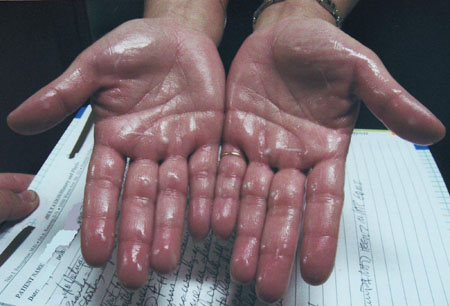Approach
For primary hyperhidrosis, history confirmed by physical examination is usually all that is required for correct diagnosis. The skillful use of strategic questions will usually predict the physical findings. For secondary hyperhidrosis, the diagnosis is more complex because a thorough physical examination and detailed laboratory evaluations are required to identify the organic pathology that is the cause of the hyperhidrosis.[2]
History
The patient's symptoms and medical history should be ascertained, including identifying any medicines the patient is currently taking and previous treatments for excessive sweating. In primary hyperhidrosis the condition may be localised and patients may report excessive hand (palmar), foot (plantar), underarm (axillary), or head/facial (craniofacial) sweating. In secondary hyperhidrosis, patients may report more generalised all-over body sweating, which may also occur during sleep.[12][13] Patients may also report changes in the amount or pattern of sweating, changes in the odour associated with sweating, and/or stained clothing. Some patients may report a family history of the condition. At least 50% of patients with palmoplantar hyperhidrosis report a positive family history.[6][7]
Primary hyperhidrosis
Physical examination
Palmar hyperhidrosis
Mild disease occurs as a moist palmar surface without visible droplets of perspiration. If palmar sweating extends towards the fingertips, the condition can be considered moderate. If sweat drips off the palm and reaches all the fingertips, it is severe.
Plantar hyperhidrosis
Usually occurs in conjunction with palmar sweating. Patients with this variety have excessive sweating of the feet that leads to moist socks and shoes.
Palmoplantar hyperhidrosis
This is severe palmar and plantar sweating, which usually has four hallmark characteristics:[9][14][15]
Severe palmar (hands) sweating to the point of dripping or near dripping
Severe plantar (feet) sweating similar to the palms
Bimodal onset, either in early childhood or at puberty (or worsened at puberty)
Exacerbation with application of hand lotion. [Figure caption and citation for the preceding image starts]: Profound sweating provoked in a patient with palmoplantar hyperhidrosis after administration of a small amount of hand lotionFrom the personal collection of Fritz Baumgartner, MD [Citation ends].

Craniofacial hyperhidrosis
History and physical examination usually point to a debilitating level of craniofacial sweating often exacerbated by emotional stress or spicy foods. The point at which normal stress-induced facial sweating becomes pathological depends on the objective quantity of sweating (e.g., dripping) and the subjective impact level of the disorder on the patient's daily activities.
It is important to consider whether normal, physiological sweating has been misinterpreted as pathological and abnormal by the patient. Therefore, the overall psychological stability of the patient should also be considered.
Axillary hyperhidrosis
The point at which normal stress-induced axillary sweating becomes pathological depends on the objective quantity of sweating (e.g., dripping down the torso) and the subjective impact level of the disorder on the patient's daily activities.
As with craniofacial sweating, it is important to consider whether normal, physiological sweating has been misinterpreted as pathological and abnormal by the patient. Therefore, the overall psychological stability of the patient should also be considered.
Objective diagnostic testing
Objective testing is generally not required for diagnostic purposes.[12] However, objective testing has been used in clinical trials to quantify the amount of sweat and it may be useful to guide treatment and follow-up.[12][16] There are two main tests: starch iodine test and gravimetry.
Starch-iodine test
This is a qualitative test that may be useful to map areas for local procedures, such as axillary sweat gland excision or botulinum type A toxin injection.[16] During the test, a 1% to 5% solution of iodine in alcohol is applied to the area in question and allowed to dry. Cornstarch is then applied and the reaction with sweat produces a purple sediment.
Gravimetry
This is a quantitative test that involves the measurement of sweat accumulation by filter paper.[2][17] Filter paper is weighed before and after contact with a sweaty body region and so provides a measure of the rate of sweat production in milligrams per minute. Axillary hyperhidrosis is diagnosed if sweat production is >20 mg/minute in males and >10 mg/minute in females.[12][17] Palmar hyperhidrosis is diagnosed if sweat production is >30-40 mg/minute.
Secondary hyperhidrosis
Diagnosis depends on recognising the underlying organic pathology that is causing the excess sweating.[2][8] For example, focal sweating may result from acute spinal cord injury, cerebral or medullary infarcts, or other nerve injuries (e.g., post-traumatic vasomotor dystrophy), and facial gustatory sweating may be caused by Frey syndrome (sweating on one side of the forehead, face, scalp, and neck occurring soon after ingesting food as a result of damage to the nerve that innervates the parotid gland). More generalised sweating may be due to endocrine, neoplastic, infectious, drug, and toxicological-related problems and, depending on the history and physical examination, may require additional testing. These disorders may include thyroid, pituitary, diabetic, infectious, and neoplastic diseases, as well as pheochromocytoma and carcinoid tumours. Acute coronary syndromes, heart failure, and rhythm disturbances may also cause sweating.[16]
Thyroid function tests, metabolic and electrolyte panel, urine evaluation for metanephrines, catecholamines, and 5-hydroxyindoleacetic acid, plain x-ray, and CT scanning can help distinguish between thyroid, pituitary, diabetic, infectious, and neoplastic disorders, as well as phaeochromocytoma and carcinoid tumours. An ECG and echocardiogram may be helpful to rule out acute coronary syndromes, heart failure, and rhythm disturbances.
Use of this content is subject to our disclaimer